The Story of
|
|
The modern icon of Saint Faith, the
work and
gift of Mrs Margaret Bell, displayed in our church's Lady Chapel.
Visit the Virtual Tour Lady Chapel page link for details of another
icon
by Mrs Bell.
The
icons hang in the Lady Chapel in Saint Faith's |
 June 13th, 2009: New information about Saint Faith
added... see the red box below
June 13th, 2009: New information about Saint Faith
added... see the red box belowThis page tells something about our patron Saint Faith, her association with the shrine at Conques in France, and statues and pictures of her there and in our church and elsewhere.
There are quite a few churches dedicated to our patron in Britain and throughout the world. Follow THIS LINK to read about those we have discovered, and to access the list we have compiled of their locations - and to find out about her ferry, her crematorium, her asylum, her token - her garage and her pub....! The list, and associated articles and pictures, are updated whenever new information is found.
Most Anglican churches bear not only the name of their geographic location, but also a dedication to a 'patron' - sometimes a member of the Holy Trinity (Christ Church, Holy Spirit etc), but more often that of a Saint of the Christian Church. Saints are remembered in the church's calendar on dates set aside for the purpose, and such dates are known as the church's Patronal Festival. At these festivals congregations give thanks for the past and rededicate their efforts for the future.
Saint Faith`s Day
in the Anglican
calendar falls on October 6th
and every year, special
services
are held at our church. The High Mass of Thanksgiving recalls the life
and witness of Saint Faith herself, and remembers the priests and
people
past and present who have served the church since its dedication in
1900.
|
Who was Saint Faith? Little is in fact known of our patron, and no-one seems sure why Douglas Horsfall, our founder and benefactor, named his new church, consecrated in 1900, after a young French virgin and martyr. It is believed that Faith lived in the 3rd and 4th centuries at the time of the Roman Emperor Maximilian (286-305 AD) and died in Agen in the Garonne Valley in French Aquitaine. According to Jean-Claude Foy’s ‘Visiting Conques’, ‘a young Christian girl named Foy’ (from the Latin ‘Fides’) refused to make a sacrifice to pagan gods and was put to death by the occupying Roman authorities on the orders of the Governor Dacian, who had her roasted on a brazen bed and then beheaded. Other versions of the story record a miraculous shower of rain extinguishing the fire and necessitating the subsequent beheading. Faith was just twelve years old at the time. ‘Other Christians from Agen,’ Fau relates, ‘among whom were Bishop Caprais, moved by her example, submitted in their turn to an agonising fate.’ (see the red box below: Caprais is obviously Caprasius) Her body, secretly buried, was transferred two centuries later to the basilica constructed on the actual place of her martyrdom. ‘It is quite certain’, Fau says, ‘that the various accounts of her Passion related well after her death, evoke more the feeling of ‘The Golden Legend of the Lives of the Saints’ than any historical reality.’ Five centuries later, it appears that romantic legend became closer to reality when ‘the names of Sainte Foy and Conques became associated for ever.’ Towards the end of the 8th century, a hermit called Dadon settled to a life of contemplation in that remote valley, and a community of monks joined him, following the Benedictine rules. Following a grant of land from the Emperor Louis the Pious (son of Charlemagne), the community began to flourish. At a time when the worship and valuing of holy relics was growing – and the possession of relics were coming to be seen as conferring great prestige - the Conques community set about obtaining some. ‘After several fruitless attempts’, Fau recounts, ‘ they set their heart on obtaining the precious remains of Sainte Foy at Agen. The theft, obliquely referred to as the ‘discreet transfer’(!) took place in the year 866 AD.’ Other accounts tell the entertaining story of the Conques monk who apparently attached himself to the Agen community, won their confidence and was entrusted with the task of guarding the relics. Once alone, he took to the hills with Saint Faith, evaded his righteous pursuers and found sanctuary in Conques, on January 14th, 866, where our saint’s remains (if that is what they actually are) remain to this day. The abbey was rededicated to Sainte Foy and, discreetly glossing over its highly questionable acquisition, grew and prospered. Crusaders and pilgrims going to the shrine of St James at Compostella invoked her intercession and heaped treasures and gold on the community. The celebrated reliquary jewel-encrusted statue of the saint dates from this time and has long revered as a memento of her life and death. There were two other, more historically authenticated,
dramatic episodes
in Saint Faith’s journey down the centuries. In 1568, at the height of
the Reformation, the Huguenot Protestants set fire to the abbey,
burning
the roof down and doing much damage. At the time of the French
Revolution,
in 1792, the monastery was suppressed and scattered, and its mediaeval
treasures, including the ‘Majesty of Sainte Foy’, were taken out of the
decaying abbey and hidden in villagers’ homes, walls and outbuildings
to
avoid being requisitioned and melted down. The monastic buildings did
not
survive, but the abbey was restored and its treasures recovered and
reinstalled.
|
 |
 In June 2009,
more 'facts' about our patron saint came to light. The article that
follows, reproduced from our parish magazine 'Newslink' explains it all. In June 2009,
more 'facts' about our patron saint came to light. The article that
follows, reproduced from our parish magazine 'Newslink' explains it all.Following up Saint Faith The trail of our patron saint has not gone cold. After quite an interval of time, there comes news of her life and legend - and of yet another (possible) dedication to her name. Mary Rae, the esteemed descendant of our equally esteemed founder, Douglas Horsfall, has provided an article headed ‘Historical Notes’, which she says ‘was printed in 1866, when HDH was ten years old’. It gives information about ‘our’ saint, with the usual basic story, but with some interesting little extras. Faith, the daughter of Christian parents, was, according to this account, ‘of remarkable beauty, but insensible to the allurements of the world.’ Her steadfastness in the faith, her refusal to sacrifice to Diana and her painful martyrdom, are all faithfully recorded. She is ‘represented with a crown on her head, her body stripped to the waist (not in any of our pictures or statues! Ed.); a clasped book or a sword is in one hand, while the other rests on a brazen bed or holds a bundle of rods’ (she was ‘half-roasted’ on the former after having been beaten with the latter.) Our statue, as is the case of some of the other images of the girl, do indeed show a clasped book (contents unspecified) but she is usually holding a palm rather than a bundle of rods. Following the trail of linked references on Google, further interesting details appear, some of which this writer had not come across before. I suppose I should have known that the Spanish for our saint is Santa Fe (hitherto more associated by this writer with an American railroad!) The story proclaimed of the appropriation (or theft) of her relics from Agen (where she was martyred) to Conques is well enough known. It is claimed online, however, that ‘during the ninth century, Faith’s cult was fused with that of Caprasius of Agen and Alberta of Agen. One legend apparently states that during Christian persecution, Caprasius fled to Mont-Saint-Vincent, near Agen, where he witnessed the execution of Faith from atop the hill. Caprasius was condemned to death along with Alberta, Faith's sister, and two brothers. All four, according to the story, were beheaded.’ (Wikipedia declares that Alberta of Agen is a saint of the Roman Catholic Church, martyred at the same time as St Faith, but does not mention her as a sister. Her feast dayu is the website manager's birthday... March 11th) Finally, this revealing site says that her legend portrays her as a patron who could turn against those who only gave small donations to her church at Conques! Miracles associated with Faith are referred to as joca - Latin for ‘tricks’, or ‘jokes’. And so the story grows in detail, and the ‘legend’ is fleshed out with a family and a black sense of humour. Whether or not Faith existed, with or without siblings and index-linked miracles, her cult is world-wide and, as we know, there are quite a few churches and other places and things dedicated to her name. Mary Rae’s cutting speaks of ‘sixteen churches in England… named in her sole honour, and Little Wittenham, Berks, in the names of Saint Faith and All Saints’. As a matter of record, the current English tally stands at 38, without the Little Wittenham church. Searches now reveal the existence of a church there, but it is dedicated to St Peter. However, a footnote to one website seems to imply a historical dedication to St Faith and All Saints, so it’s now on the list. |
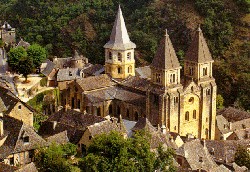
|
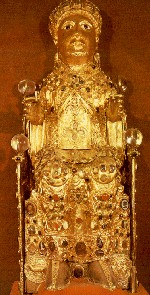 |
| (right)
A mediaeval image of Saint Faith. It is one of a series of cloisonne champleve enamel figures decorating the border of the early 12th century Sainte Foy portable altar, part of the splendid Conques Treasure. The Latin inscription reads Sancta Fides |
 |
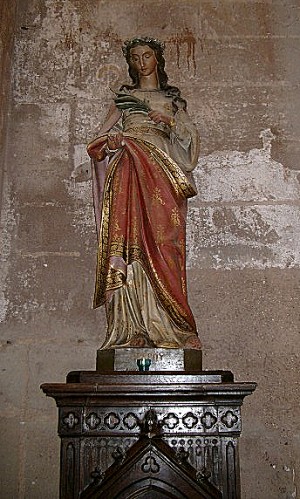 |
(left)
The statue of Saint Faith in the Cathedral at Rodez, France, in which Diocese the Abbey of Conques is situated. The inscription at the base of the statue reads 'Ste Foy'. Photograph by Denis Whalley |
Not surprisingly, no actual pictures of Saint Faith survive: only stylised or figurative picturings. Indeed, her very existence is uncertain and many of the stories accruing to her over the centuries are more than likely to be mere legends. But the strength of her sacrifice and story, the devotion it has inspired, and the continuing life of the churches throughout the world which bear her name, speak as powerfully today as they have ever done, and transcend mere questions of historical authenticity.
As we at St Faith`s in Great Crosby seek to find God`s will for our church in the 21st century, we pray in gratitude for the life and witness of St Faith – and whether she existed or not, we are increasingly grateful for what her witness has meant to us in this house of prayer. We, in communion with all other churches and communities bearing her name, continue to find in our patron saint an inspiration and a shining example of Faith.
In recent years, the church has received the generous gift of a modern hand-painted icon of St Faith by Mrs Margaret Bell (see the top picture on this page), and on January 14th 2004, the anniversary of the Translation of Saint Faith from Agen to Conques, a new and lovely statue of our patron was installed in church, and blessed by Bishop Rupert Hoare, Dean of Liverpool Cathedral. Little is known of the statue's origins, but it is thought to be of northern European orgin, and before its restoration bore the legend 'Ste Foy', now replaced by the lettering 'S. Faith'. The date and designer of the statue are not known.
The first two pictures below show the figure, bearing the palm of
martyrdom
and what is presumably a book of the Gospels.
For pictures of the
blessing service 'Saint
Faith
comes to Saint Faith's' CLICK
HERE.
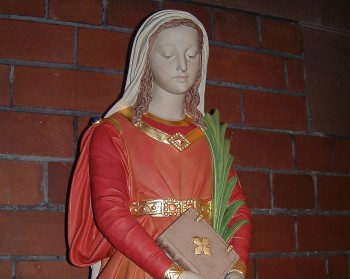 |
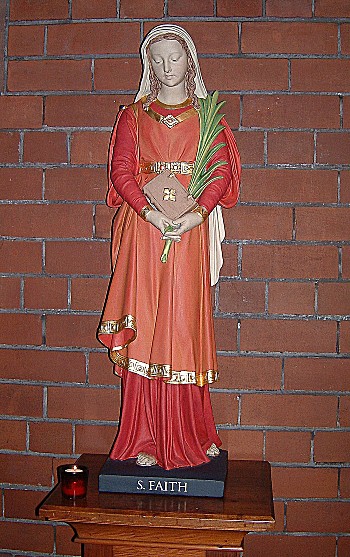 |
|
the statue of Saint Faith decorated with flowers and candles for the Patronal Festival High Mass on October 6th, 2004. |
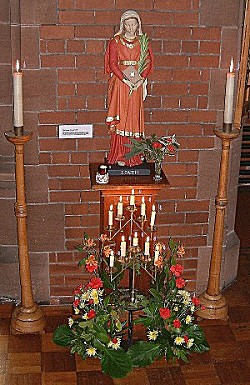 |
 |
Banners
of Faith
This picture, taken during the 2003 Patronal Flower Festival, shows two banners bearing representations of our patron saint. The
modern banner,
the work of Sister Anthony of Liverpool's Roman Catholic Metropolitan
Cathedral,
shows the flaming grid beneath her feet, as well as various symbolic
representations
of her martyrdom and her reception in heaven. A
virtual tour of
the interior of the church and its furnishings is available by
following
the link from the home page.
|
Saint Faith's goes to Saint Faith
Following an earlier expedition to Conques, October 2004 saw the first pilgrimage to Conques by members of our church, led by Fr Neil Kelley. Follow the link from the home page for words and pictures from this momentous occasion.

 One of the English churches dedicated to our
patron is the parish
church of Saint Faith and Saint Laurence, Harborne, Birmingham.
One of the English churches dedicated to our
patron is the parish
church of Saint Faith and Saint Laurence, Harborne, Birmingham.This stained glass image of Saint Faith is reproduced from their website.
Click here for the main website.
Click here for the page featuring the story of Saint Faith.
Return to St Faith's home page






